이 문서에 대해서
이 문서는 Sass의 공식 메뉴얼(http://sass-lang.com/tutorial.html)을 의역한 것으로, 더 많은 정보는 Sass 레퍼런스(http://sass-lang.com/docs.html)를 통해서 찾을 수 있다.
중첩(Nesting)
CSS의 특성으로 인해서 셀렉터를 중복해서 사용해야 하는 경우가 많은데 Sass의 Nesting을 이용하면 코드의 양을 줄이고 연관된 코드끼리 그룹핑할 수 있다.
/* style.scss */
#navbar {
width: 80%;
height: 23px;
ul { list-style-type: none; }
li {
float: left;
a { font-weight: bold; }
}
}
/* style.css */
#navbar {
width: 80%;
height: 23px;
}
#navbar ul {
list-style-type: none;
}
#navbar li {
float: left;
}
#navbar li a {
font-weight: bold;
}
셀렉터 뿐만 아니라 이름의 중복도 줄일 수 있다.
/* style.scss */
.fakeshadow {
border: {
style: solid;
left: {
width: 4px;
color: #888;
}
right: {
width: 2px;
color: #ccc;
}
}
/* style.css */
.fakeshadow {
border-style: solid;
border-left-width: 4px;
border-left-color: #888;
border-right-width: 2px;
border-right-color: #ccc; }
부모 엘리먼트를 참조(Parent References)
(마우스가 엘리먼트 위로 올라왔을 때를 의미하는) :hover와 같은 pseudoclasses의 경우는 특수기호 '&'를 이용해서 부모 엘리먼트를 참조할 수 있다.
/* style.scss */
a {
color: #ce4dd6;
&:hover { color: #ffb3ff; }
&:visited { color: #c458cb; }
}
/* style.css */
a {
color: #ce4dd6; }
a:hover {
color: #ffb3ff; }
a:visited {
color: #c458cb; }
변수(Variables)
CSS내에서 변수를 사용할 수 있다. 변수이름은 '$'로 시작해야 하고, 변수의 값으로 올 수 있는 것은 문자, 숫자(px, em포함), 칼러(#ce4dd6)가 있다. 변수를 이용하면 크기나 색상과 같은 값을 일괄적으로 변경할 수 있다.
/* style.scss */
$main-color: #ce4dd6;
$style: solid;
#navbar {
border-bottom: {
color: $main-color;
style: $style;
}
}
a {
color: $main-color;
&:hover { border-bottom: $style 1px; }
}
/* style.css */
#navbar {
border-bottom-color: #ce4dd6;
border-bottom-style: solid; }
a {
color: #ce4dd6; }
a:hover {
border-bottom: solid 1px; }
연산자와 함수(Operations and Functions)
연산자와 함수를 이용해서 엘리먼트의 크기나 좌표 또는 색상을 동적으로 변경할 수 있다.
- 연산자 : +, -, *, /, %
- 함수 : lightness, hue, saturation, 기타
/* style.scss */
#navbar {
$navbar-width: 800px;
$items: 5;
$navbar-color: #ce4dd6;
width: $navbar-width;
border-bottom: 2px solid $navbar-color;
li {
float: left;
width: $navbar-width/$items - 10px;
background-color:
lighten($navbar-color, 20%);
&:hover {
background-color:
lighten($navbar-color, 10%);
}
}
}
/* style.css */
#navbar {
width: 800px;
border-bottom: 2px solid #ce4dd6; }
#navbar li {
float: left;
width: 150px;
background-color: #e5a0e9; }
#navbar li:hover {
background-color: #d976e0; }
Interpolation
'#{}'를 사용해서 변수로 속성이나 선택자의 이름을 동적으로 치환할 수 있다.
/* style.scss */
$side: top;
$radius: 10px;
.rounded-top {
border-#{$side}-radius: $radius;
-moz-border-radius-#{$side}: $radius;
-webkit-border-#{$side}-radius: $radius;
}
/* style.css */
.rounded-top {
border-top-radius: 10px;
-moz-border-radius-top: 10px;
-webkit-border-top-radius: 10px; }
Mixins
선택자와 속성을 재활용할 수 있도록 해주는 방법이다. 선언할 때는 '@mixin'으로 시작하고, 호출할 때는 '@include'을 사용한다.
/* style.scss */
@mixin rounded-top {
$side: top;
$radius: 10px;
border-#{$side}-radius: $radius;
-moz-border-radius-#{$side}: $radius;
-webkit-border-#{$side}-radius: $radius;
}
#navbar li { @include rounded-top; }
#footer { @include rounded-top; }
/* style.css */
#navbar li {
border-top-radius: 10px;
-moz-border-radius-top: 10px;
-webkit-border-top-radius: 10px; }
#footer {
border-top-radius: 10px;
-moz-border-radius-top: 10px;
-webkit-border-top-radius: 10px; }
인자 (Arguments)
Mixin의 진정한 힘은 인자를 통해서 나타나는데, 인자는 Mixin 안에서만 사용되는 지역변수를 의미한다. 인자는 기본 값을 가질 수 있다.
/* style.scss */
@mixin rounded($side, $radius: 10px) {
border-#{$side}-radius: $radius;
-moz-border-radius-#{$side}: $radius;
-webkit-border-#{$side}-radius: $radius;
}
#navbar li { @include rounded(top); }
#footer { @include rounded(top, 5px); }
#sidebar { @include rounded(left, 8px); }
/* style.css */
#navbar li {
border-top-radius: 10px;
-moz-border-radius-top: 10px;
-webkit-border-top-radius: 10px; }
#footer {
border-top-radius: 5px;
-moz-border-radius-top: 5px;
-webkit-border-top-radius: 5px; }
#sidebar {
border-left-radius: 8px;
-moz-border-radius-left: 8px;
-webkit-border-left-radius: 8px; }
불러오기 (@import)
CSS는 @import 명령을 지원하는데, 이 명령은 다른 CSS를 불러오는 것이다. 이것은 별도의 파일을 네트워크를 통해서 로딩하는 것인데, 네트워크 커넥션은 느리고 비싼 행위다. Sass에서 import는 그 파일의 내용을 실제로 가져와서 파일에 통합하다.
Sass는 import를 위한 이름규칙이 있다. 불러지는 파일은 partials라고 불리고, 이 파일은 '_'로 이름이 시작된다. 예를들면 _rounded.scss 와 같은 식이다. 이 파일을 불러올 때 Sass에서는 @import 'rounded'를 사용한다.
/* _rounded.scss */
@mixin rounded($side, $radius: 10px) {
border-#{$side}-radius: $radius;
-moz-border-radius-#{$side}: $radius;
-webkit-border-#{$side}-radius: $radius;
}
/* style.scss */
@import "rounded";
#navbar li { @include rounded(top); }
#footer { @include rounded(top, 5px); }
#sidebar { @include rounded(left, 8px); }
/* style.css */
#navbar li {
border-top-radius: 10px;
-moz-border-radius-top: 10px;
-webkit-border-top-radius: 10px; }
#footer {
border-top-radius: 5px;
-moz-border-radius-top: 5px;
-webkit-border-top-radius: 5px; }
#sidebar {
border-left-radius: 8px;
-moz-border-radius-left: 8px;
-webkit-border-left-radius: 8px; }



